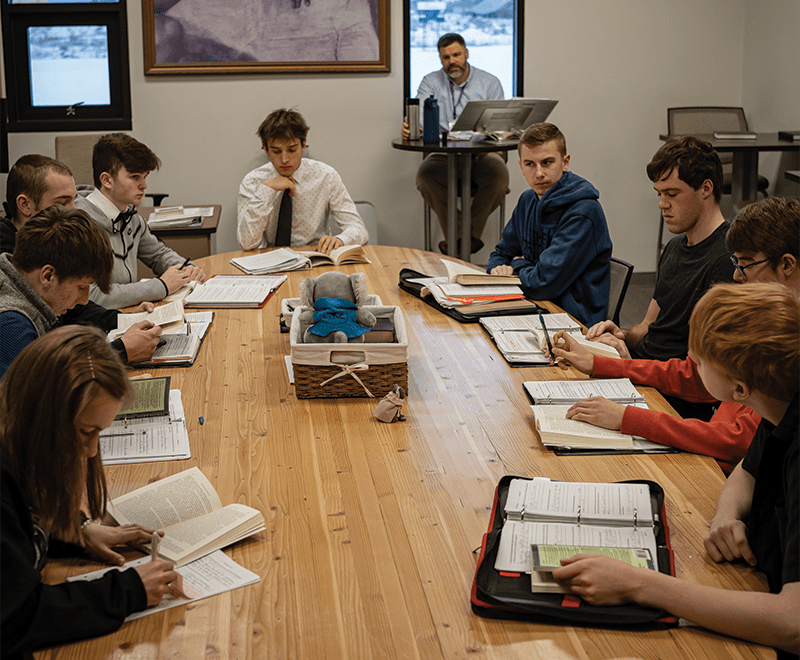Harkness Discussions at Stillwater

HARKNESS DISCUSSIONS AT STILLWATER
by Mr. Micah Tinkham, HS Bible & Rhetoric Teacher
WHAT IS HARKNESS?
Perhaps you’ve been down the high school hallway for a tour and have seen students seated around a table in discussion, with the teacher looking on from desk or chair, or been seated at your own dinner table, where your child tells you he or she has to prepare for a Harkness discussion. “In my day,” you might think, “the teachers did the teaching and the students did the learning, lined up in ordered rows. What’s going on here?”
What you are witnessing is a Harkness discussion, a student-led pedagogical model that has proven to be one of the greatest engagement and learning tools available to teachers. In a Harkness discussion, students are required to read a text carefully chosen by the teacher before the discussion. The students then annotate the text, or write questions they have about it, or answer questions prepared by the teacher for them. When the discussion comes, these resources become the seedbed for our desired outcome: a charitable, thoughtful, inclusive exchange of ideas. What a teacher may lose in efficiency (a lecture could cover the material more quickly), the students gain twice over in engagement and learning.
As senior Zoe Linn has put it, “One of the things that I appreciate about the Harkness discussion is that it encourages group participation due to its student-led structure. I am challenged to discuss and defend my beliefs in order to better understand and learn the topic.” Fellow senior Lleyton Stoll adds, “Harkness opens up a time for discussion about topics that otherwise may not be brought up in everyday conversation, and allows for ideas to flow through it that others may be confused about.” These students pinpoint some of the strengths of the Harkness model. Zoe connects the student-led format with greater understanding, and Lleyton notes that Harkness provides for unique content focus and opportunities for students to teach each other. These are all goals teachers have in mind when designing these lessons.
HOW IT WORKS
An effective Harkness discussion requires more than rearranging the desks and assigning a chapter of reading. Students need to be trained to use this model to its greatest benefit, first learning the rules, then quickly developing skills through practice. Students learn to ground their comments in the text, bringing reasoning and evidence together to cultivate critical thinking. They learn to include everyone, aiming for equal talking time around the table. They learn to challenge one another respectfully, avoiding the equal and opposite errors of ignoring blatant falsehood for the sake of fragile egos or of immediately attacking those whose views differ from their own. For it is only when challenged that our thinking really develops, and it is only when respected that we are willing to honestly speak.
As students grow more comfortable with these discussions, their frequency increases. Freshmen have a handful of Harkness discussions each semester, and seniors study whole books this way, spending about one third of their Senior Seminar class time in discussion. As they learn more, they can make more connections between the new material and the known material. As they grow in wisdom and confidence, our focus on their ability to articulate their views, which can only happen through their own expression, increases.
We stand behind Harkness discussions because they challenge students to think for themselves, and we believe learning how to think is more important than just knowing stuff. We also know that our graduates will face cultural challenges to Christian thinking that we have not had to face, and that their faith must be their own if they are to successfully serve and lead wherever God calls. As senior Abby Stillo puts it, “Harkness provides a unique opportunity to discuss theological topics and dig deeper into fundamental issues of our faith.” May this preparation be for our students’ good and for the greater glory of God.

